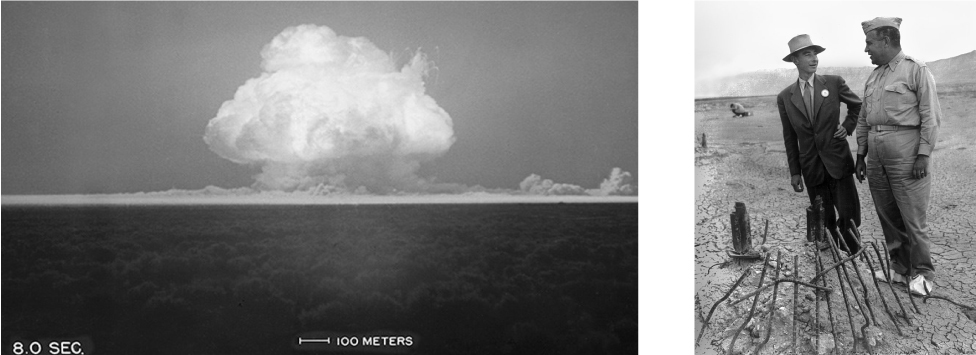
Lecture Series by Fulvio Parmigiani (University of Trieste and University of Cologne)
Donnerstag, 10.11., 17.11., 24.11., 10am
Seminar room of II. Physics Institute
The nuclear bombs (also known as atomic bombs) are powerful weapons that use nuclear reactions as their source of explosive energy. Scientists and engineers first developed nuclear weapons technology during World War II in the frame of a project, known as Manhattan Project, fully funded the US Government and directed by J. Robert Oppenheimer and General Leslie Groves.
Atomic bombs have been used only twice in war—both times by the United States against Japan at the end of World War II, in Hiroshima and Nagasaki.
The test, codenamed “Trinity,” took place on July 16, 1945, in the desert at Alamogordo, New Mexico, 200 miles south of Los Alamos. The device, mounted on a metal tower, consisted of just 13.5 pounds of plutonium encased in two-and-a-half tons of explosives. It exploded at 5:29 a.m. to devastating effect, equal to the detonation of almost 20,000 tons of TNT. Groves and Oppenheimer witnessed the atomic fireball expand into a mushroom cloud visible 60 miles away. Horrified by what he saw, Oppenheimer called to mind words from the Bhagavad Gita: “Now I am become Death, the destroyer of worlds.” But it was too late to turn back. The world had entered the nuclear age.
On August 6, the Enola Gay, a B-29 Superfortress, dropped the uranium bomb nicknamed Little Boy, which exploded with the force of 12,500 tons of TNT 1,900 feet above the Japanese city of Hiroshima. With a blinding flash and rising mushroom cloud, the blast and resulting firestorm obliterated the city and destroyed 70,000 buildings. People were vaporized from the blast and their shadows imprinted on walls. President Truman sent public messages announcing the dropping of an atomic bomb and threatened more if Japan refused to surrender. Still, the Japanese government fought on.
On August 9, another B-29 bomber dropped a plutonium bomb called Fat Man on Nagasaki, with an even larger blast equivalent to 22,000 tons of TNT. Due to significant cloud cover this second bomb missed its target by a wide margin, somewhat limiting its destructive impact. Nevertheless, it killed at least 30,000 people and caused suffering for thousands of survivors. Over the next five days, conventional bombings of other major cities killed an additional 15,000 Japanese. Finally, on August 14, Japan surrendered and World War II ended.
A period of nuclear proliferation followed that war, and during the Cold War, the United States and the Soviet Union vied for supremacy in a global nuclear arms race.
Here I will report a short history of the origins and development of the American atomic bomb program during World War II. Beginning with the scientific developments of the pre-war years, the details the role of United States government in conducting a secret, nationwide enterprise that took science from the laboratory and into combat with an entirely new type of weapon.